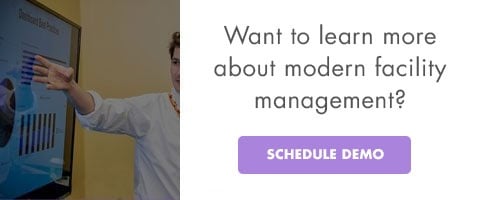4 of the Most Common Facilities Management Issues


Extraordinary workplace leaders become aware at some point in their career the need to be a corporate chameleon — a professional who can adapt their workstyle to properly communicate with different types of people and resolve various facilities management issues. 
 Although the facilities leader may not actively compare himself or herself to a reptile, the fact remains: Workplace leaders must be able to quickly respond to changes in the environment and mitigate risks.
Although the facilities leader may not actively compare himself or herself to a reptile, the fact remains: Workplace leaders must be able to quickly respond to changes in the environment and mitigate risks.
Workplace leaders may not have to worry about avoiding birds and finding crickets, but they certainly face their own set of unique challenges in terms of facilities management issues.
Here are four of the most common facilities management challenges.
Top Facilities Management Issues
- Forced to Use Outdated Data
- Implementing New Technology
- Allocating Time Effectively
- Managing Aging Real Estate
1. Forced to Use Outdated Data
Data is the lifeblood of successful FM, and unfortunately, many workplace leaders have to make due with data that is not only inaccurate and out of date but also difficult to access. Or if they do have accurate data, it’s not easily quantifiable or actionable. To complicate matters, many times employees will move spaces on their own, without scheduling a move with the FM team, leading to constantly out-of-date floorplans.
As a result, the workplace leader can’t make sound decisions since he or she can’t be confident about the source or veracity of the data.
2. Implementing New Technology
New technology can present facilities management issues in multiple ways. Workplace leaders must overcome two distinct hurdles when attempting to implement new workplace technology.
The first is ensuring the workforce actually uses the technology. Employees might resist change, especially when that change requires taking time away from their existing workload to learn how to use software that they feel won’t improve their productivity.
The second is receiving IT support once the workplace leader has managed to convince the workforce to adopt the technology. Often, members of the IT department will de-prioritize FM requests in favor of other service tickets they deem more important. And when the IT team does finally address the technology issue, it could be months after it was first reported.
 3. Allocating Time Effectively
3. Allocating Time Effectively
Due to insufficient staffing levels, many workplace leaders are spread too thin and are unable to allocate their time to matters outside the management of the day-to-day minutiae.
For example, most workplace leaders would prefer they had the opportunity to review business operations as a whole and gain better visibility into space utilization across the enterprise. With this insight, the workplace leader could effectively forecast and identify ways to save the company money. But because of their substantial workload, this isn’t often an option.
In addition to the inability to analyze space and occupancy data in a more impactful way, workplace leaders sometimes sacrifice the chance to attend networking events and career development seminars since they fear an issue only they can resolve might arise after they leave the campus.
4. Managing Aging Real Estate
Aging real estate can present a number of facilities management issues. Maintaining older facilities tends to be more expensive than maintaining newer real estate as repairs and maintenance are required more frequently. For example, aging real estate has older windows and less effective insulation, which means having to run the HVAC system more often. If the HVAC system is almost constantly on, the equipment will break down more quickly than in a facility where the HVAC system can be cycled off and on.
Additionally, because manufacturers in the past were less concerned with being green, older buildings were not designed with energy conservation in mind. Updating a facility to be more environmentally friendly (such as replacing incandescent light bulbs and disposable kitchen supplies) is not cheap.
Being a corporate chameleon is no easy feat. But workplace leaders who recognize the potential impact of these common facilities management issues and have a gameplan in place for overcoming them will find it much easier to change their colors and adapt to the new situation. A facility management software plays an important role in recognizing and solving these issues.
Ready to become an exceptional workplace leader? Check out our free SlideShare, 8 Innovative Tools for Extraordinary Facilities Managers, and see how you can become a facilities superhero.



